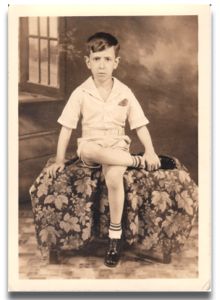 "Every town, city and suburban family with a plot of sunny, open space of suitable soil, or access to a community or allotment garden, can make an important contribution to our national food program and our war effort by growing a victory garden."
"Every town, city and suburban family with a plot of sunny, open space of suitable soil, or access to a community or allotment garden, can make an important contribution to our national food program and our war effort by growing a victory garden."So declared then Secretary of Agriculture Claude R. Wickard in early 1943. Thus, the Victory Garden became not just a means of supplementing food supplies and alleviating the need for extensive food rationing, but also emerged as one of the more pronounced aspects of World War II era popular culture. In the same statement, Wickard went on to say:
 "This year we need more food than ever before in history. We need it for our men at the battlefronts, and those in training. We need it to keep the folks at home healthy and strong.
"This year we need more food than ever before in history. We need it for our men at the battlefronts, and those in training. We need it to keep the folks at home healthy and strong."Farmers broke all records in food production last year for the third time in succession. They are ready to do their level best to produce even more this year. All they can possibly produce of most foods will be needed. In many cases, more than can be produced on our farms will be needed. We simply can't get too much of some kinds of food. Every farm family, of course, will be expected to have a garden for home use and, if possible, to provide extra supplies of vegetables for nearby markets.
"The entire national food situation will be tremendously helped, and our total food needs more easily supplied, if those who have suitable ground will grow all the vegetables required for the family. Special attention should be given to green and leafy vegetables, yellow vegetables and tomatoes, because these kinds bring valuable vitamins and minerals right to the family table."
Shortly after the Secretary made his pronouncement, Time Magazine noted:
"This year Victory gardens have the Agriculture Department's blessing: Secretary Claude Wickard wants 12,000,000 in cities, 6,000,000 more on farms. The Department has arranged for production of a special Victory Garden Fertilizer and is ready with all kinds of free advice and pamphlets. Seed companies have keyed their advertising to Agriculture's campaign. From almost any catalogue, neophyte gardeners can choose a victory garden combination ($1 and up) with full instructions how, when and where to plant it. With a little luck and work, they will have fresh vegetables on their tables all summer. With a normal dose of inexperience, they will also waste a lot of seed and fertilizer.
"If Claude Wickard gets his 18,000,000 Victory gardens, food rationing will have much less sting this summer. The Agriculture Department estimates that every city garden will produce at least $10 worth of vegetables, every farm garden at least $50. At these figures, Victory gardens should yield a $420,000,000 crop."

Americans rose to the call. Nearly 20 million Victory Gardens were planted and tended in 1943. They grew out of farm plots, back yards, vacant lots and building rooftops. It was estimated that those gardens produced closed to 40% of the country's food supply that year. The initiative was so successful that public figures worried that a restored food supply would cause complacency among the new found Victory Gardeners and they would lay down the shovels and hoes the following season. Hence a "Dig More in '44" campaign was launched to insure continued participation and bounty. An article in the April 1944 issue of Modern Mechanix noted:
"Canned goods have recently been so plentiful that a few people, watching the points go down, have, like the grasshopper in the fable, questioned whether they should work a garden this summer or not.
"The answer to these slightly disillusioned persons is that they mustn't be fooled by any temporary signs of a food surplus, for this is more apparent than real. Food officials in Washington and authorities everywhere are really concerned about the needs for food that lie just ahead. after the invasion starts.
"The prudent householder will, therefore, garden this year as ardently as in 1943 and on as extensive a scale as his facilities, time and energy permit."
 The Department of Agriculture produced numerous materials to promote Victory Gardens. Posters, pamphlets and extensive instruction manuals were readily available to an eager populace. Seed companies and hardware vendors were quick to also promote the effort for commercial as well as patriotic reasons. A booklet entitled ABC of Victory Gardens and sponsored by the Paragon Oil Company of New York, proclaimed to its readers:
The Department of Agriculture produced numerous materials to promote Victory Gardens. Posters, pamphlets and extensive instruction manuals were readily available to an eager populace. Seed companies and hardware vendors were quick to also promote the effort for commercial as well as patriotic reasons. A booklet entitled ABC of Victory Gardens and sponsored by the Paragon Oil Company of New York, proclaimed to its readers:
YOU MUST HAVE A GARDEN THIS SUMMER!
You may not be able to carry a gun or drive a tank, but you can grow food for Victory! The scarcity of food is no longer something that may happen--it is here RIGHT NOW! Canned, dried and frozen vegetables have been rationed. Some experts estimate that we will receive about 70% of the amount that we had last year. WHY NOT RAISE YOUR OWN? Have as many of them as you want! Have the finest tasting vegetables a king could have, gathered fresh from your own garden.
 Numerous Hollywood movies and cartoons made reference to V-Gardens. Eddie "Rochester" Anderson cultivated one in the movie What's Buzzin' Cousin? Numerous cartoons released in 1943 featured Victory Garden storylines. Popeye grew a beanstalk out of his Victory Garden in Ration for the Duration. He climbed it, only to encounter a giant who was hoarding not treasure, but valuable war rations. Both MGM's Barney Bear and Walter Lantz's Andy Panda starred in Victory Garden cartoons, and a Victory Garden was employed as a gag in the Warner Brothers short A Tale of Two Kitties.
Numerous Hollywood movies and cartoons made reference to V-Gardens. Eddie "Rochester" Anderson cultivated one in the movie What's Buzzin' Cousin? Numerous cartoons released in 1943 featured Victory Garden storylines. Popeye grew a beanstalk out of his Victory Garden in Ration for the Duration. He climbed it, only to encounter a giant who was hoarding not treasure, but valuable war rations. Both MGM's Barney Bear and Walter Lantz's Andy Panda starred in Victory Garden cartoons, and a Victory Garden was employed as a gag in the Warner Brothers short A Tale of Two Kitties.When the war ended in 1945, Victory Gardeners prematurely abandoned their vegetable plots, causing some food shortages well into the following year. In the post war years, Victory Gardens became little more than memories of home front resourcefulness and patriotism.
Be sure to visit 2719 Hyperion to discover Disney's Victory Gardens.








2 comments:
Amazing how things go round in circles - this is a good lesson on growing your own!
Call me dumb, but I never put together the "I been a baaaad boy" from Abbott & Costello together with "I been a baaaad puddy-tat!" from these cartoons. Mainly because I was seven when I last saw them.
1. You've invigorated my interest in Abbott and Costello.
2. Boy, World War 2 was FASCINATING, all around. I never knew about Victory Gardens before. This is fascinating stuff!
Post a Comment